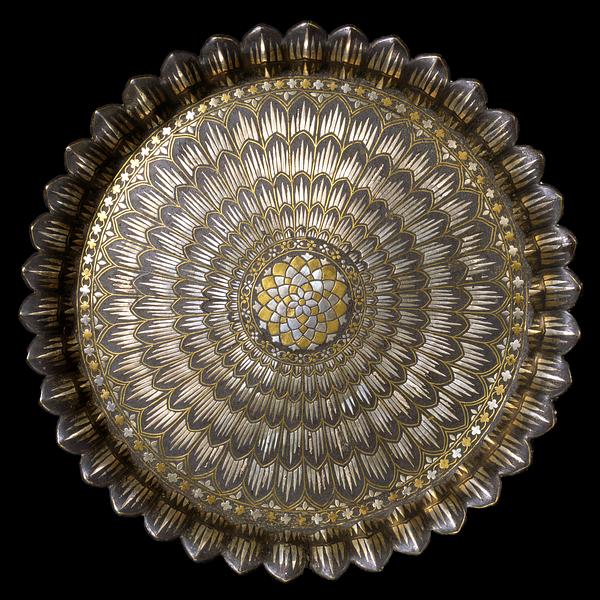Dish of bidri metal, inlaid with silver and brass
India, Deccan; 2nd half of 17th century
H: 3.5; Diam: 31 cm
The pattern on this dish made of bidri metal is evidently unique and at the same time very striking. At the very center is a flower with seven petals, surrounded by intricately arranged little leaves that seem to form a two-colored peony. A quatrefoil frieze is followed by five concentric rows of leaves with silver stripes and brass contours. The two-dimensional leaves finally give way to similar three-dimensional leaves, which make up the rim of the dish. The dish can thus be viewed as a large flower, but also as a shining sun or a stylized explosion of fireworks.
Trays of this kind were often made for ewers or water pipes with matching patterns.
Inv. no. 16/1987
Published in:
Kjeld von Folsach: Islamic art. The David Collection, Copenhagen 1990, cat.no. 357;
Kjeld von Folsach, Torben Lundbæk and Peder Mortensen (eds.): Sultan, Shah and Great Mughal: the history and culture of the Islamic world, The National Museum, Copenhagen 1996, cat.no. 348;
Mark Zebrowski: Gold, silver and bronze from Mughal India, London 1997, fig. 512;
George Michell and Mark Zebrowski: Architecture and art of the Deccan Sultanates, Cambridge 1999, fig. 180, p. 241;
Kjeld von Folsach: Art from the World of Islam in The David Collection, Copenhagen 2001, cat.no. 538;
Sheila S. Blair and Jonathan M. Bloom (eds.): Cosmophilia. Islamic Art from the David Collection, Copenhagen, McMullen Museum of Art, Boston College, Boston 2006, cat.no. 56;
Navina Najat Haidar and Marika Sardar: Sultans of Deccan India, 1500-1700: opulence and fantasy, Metropolitan Museum of Art, New York, New Haven 2015, cat.no. 94;
Linda Komaroff (ed.): Dining with the Sultan: the fine art of feasting, Los Angeles County Museum of Art, Los Angeles 2023, p. 80 and cat. 47b, pp. 196-197;
